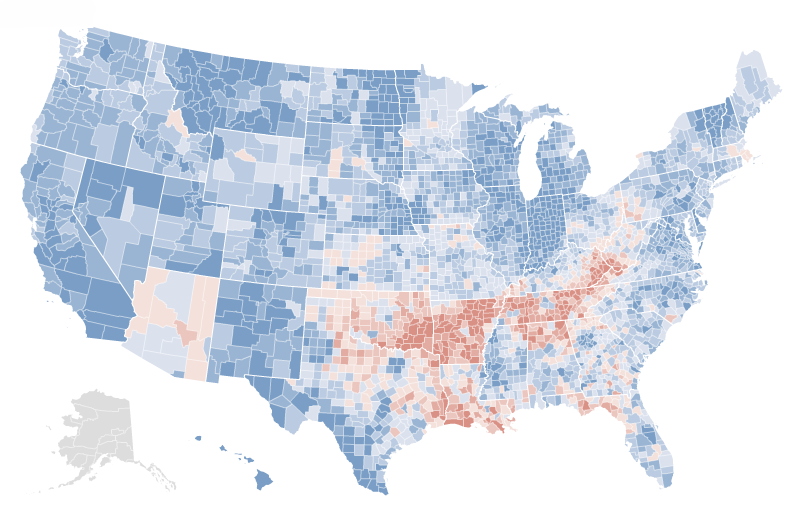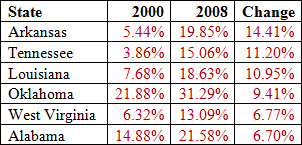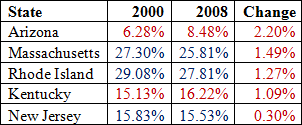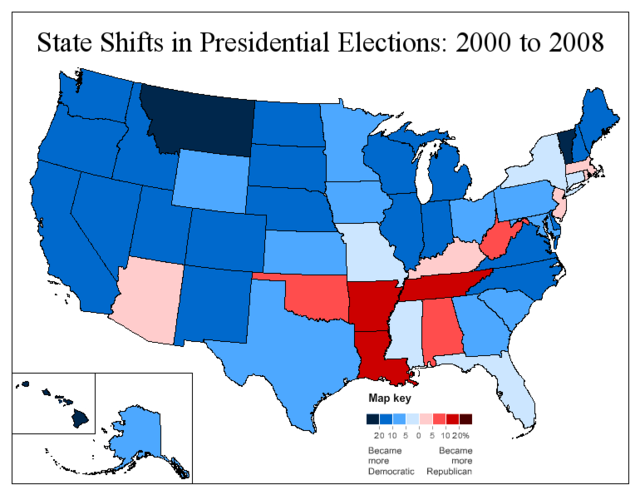By: Inoljt, http://mypolitikal.com/
Several days after the 2008 presidential election, the New York Times produced a famous map of voting shifts since 2004. Most politics buffs have seen this map; according to it, Appalachia “voted more Republican, while the rest of the nation shifted more Democratic.”

There is something else occurring here, however, which the map hides – and which almost nobody has perceived. This trend goes strongly, strongly against conventional wisdom.
To unearth this trend, let’s move back one election – to former Vice President Al Gore’s 2000 tie with former President George W. Bush. Before going below the fold, I invite you to guess – which states did Mr. Gore do better than President Barack Obama?
Here are the states he performed best relative to President Barack Obama. In all these, Mr. Gore did at least five percent better than Mr. Obama.
By and large, these states are what one would expect. All are located in the midst of Appalachia or the Deep South, regions rapidly trending Republican. All were fairly unenthused by Obama’s themes sounding change and hope.
Here are the remaining states in which Gore improved upon Obama:
This result is something quite different. Arizona – Senator John McCain’s home state – is not surprising, nor is Appalachian Kentucky.
Massachusetts, Rhode Island, and New Jersey, on the other hand – these constitute core Democratic strongholds. The vast majority of pundits would characterize them as becoming more Democratic, if anything at all. Indeed, there has been much ballyhoo about the Northeast’s Democratic shift – how Republicanism is dead in the region, how every single New England congressman is a Democrat, how Obama lost only a single county in New England.
That Al Gore performed more strongly than Barack Obama in Massachusetts, Rhode Island, and New Jersey runs strongly against this hypothesis. Remember, too, that Obama won the popular vote by 7.3% while Gore did so by only 0.5%. If the two had ran evenly, this trend would have been far more pronounced. The state in which Obama improved least upon Gore, for instance, was not Alaska or Mississippi – but New York, where Gore did only 1.88% worse than Obama. The map below indicates this:
Much of the movement derives from the Republican candidates in 2000 and 2008. George Bush was a terrible fit for northeastern voters, with his lack of intellectual depth and cowboy persona. John McCain, on the other hand, was a man many northeasterners admired – he had a strong brand of independence and moderation, which the campaign tarnished but did not destroy. McCain was a person New England Republicans could feel comfortable voting for – and they did. (Fortunately for Democrats, there are not too many Republicans left in the Northeast.)
All in all, the Northeast’s relative movement right constitutes a very surprising trend. Few people would anticipate that Al Gore did better than Barack Obama in Massachusetts, Rhode Island, and New Jersey. It defies conventional wisdom and the common red-blue state dynamic, which holds that the northeast is permanently Democratic. Finally, given increasing political polarization, this relative trend the other way probably is a good thing for the country.


